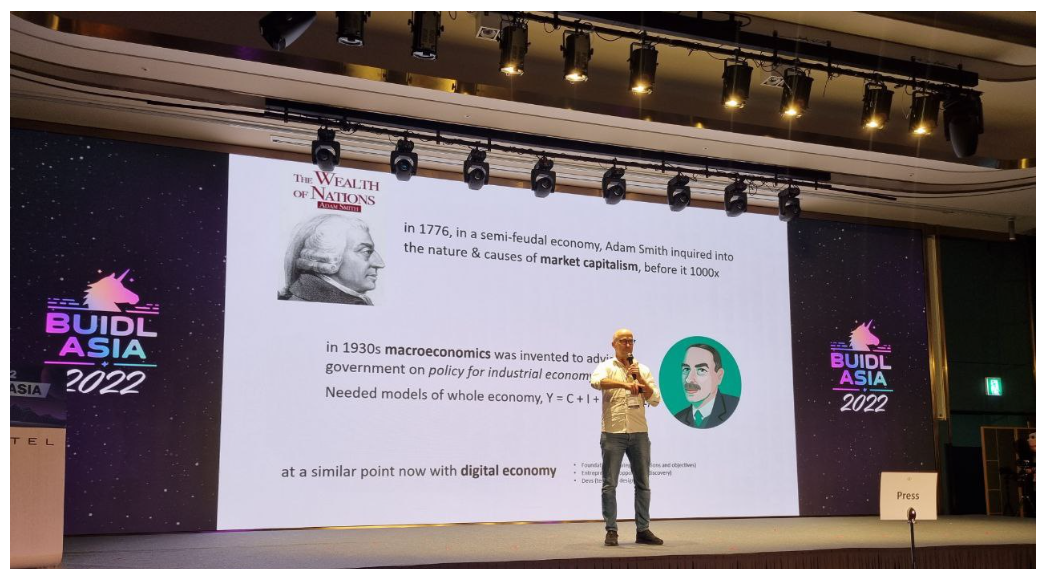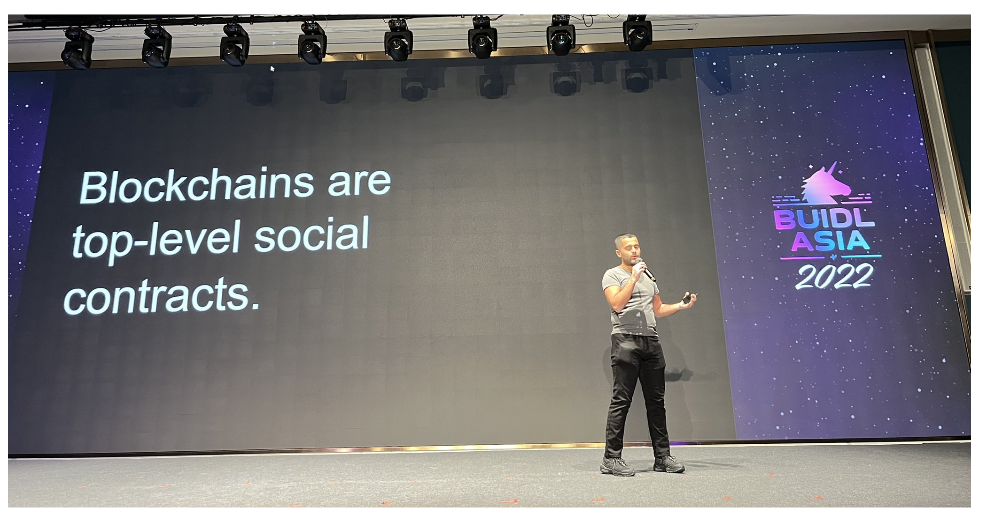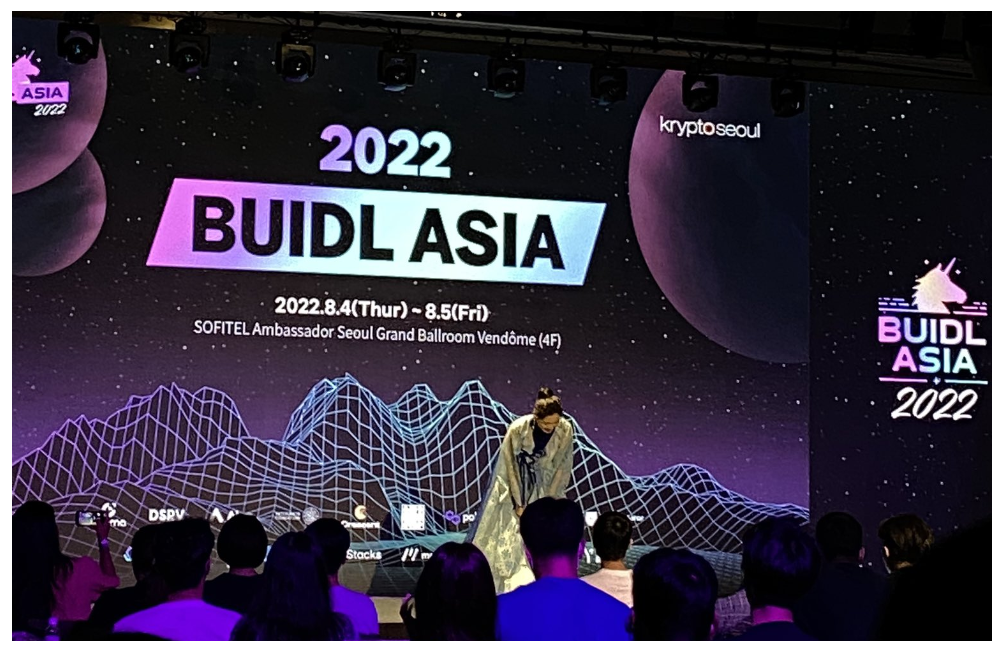Hosted and organized by KryptoSeoul, BUIDL Asia 2022 took place on August 4-5, bringing the ultimate opportunity to interact among developers, communities, and businesses across the globe.
August 5, 2022
Yap Global
Despite what regulation news are telling us about what the lawmakers have got planned, the affair between South Korea and digital assets isn’t stopping anytime soon, and this week at BUIDL Asia has been proof of that.
🌟 Another jam-packed day full of talks, panelist discussions and thought-provoking sessions on some of the toughest questions the industry has been facing lately: “Are stablecoins dead? What will drive mass adoption now? Why do user friction points still exist? What to make of this bear market?”
Eric Turner (VP of Market Intelligence, Messari) kicked us off on the importance of Cutting through the noise in the DeFi Markets, at a time when it’s crucial to reflect on where we’ve been, where we are, and where we’re headed. The real question is how can these protocols build a more sustainable user base?
“The thing about DeFi is there’s real revenue by these protocols, so users are able to see cashflows, compared to other parts of crypto, said Turner.
He believes real world assets such as real estate and accounts receivables that are off the blockchain, are back in focus, as lending protocols focus on ways they can onboard these types of assets that have higher cash flow potential.
“Stickiness of a user base is the biggest thing for DeFi protocols, and stablecoins is probably the most interesting and important part of DeFi. To truly have decentralized and unstoppable applications, we need to think about how to grow stable value assets, in collateral debt or algorithmic stablecoins (models of stablecoins).”

Jason Potts (Professor & Director, RMIT University & Blockchain Innovation Hub), who set up the world’s first blockchain research centre in 2017, took us back to the fundamentals of Adam Smith economics and challenged us to think widely: Beyond tokenomics, what do the digital economies that we end up building look like and how do we make sense of them?
“We’re transitioning from 250 years of industrial economy into a digital economy, that is better, faster, cheaper, and we need a new set of economic theories and mental models for how to understand that. And what does it do to knowledge? The huge benefit of digital economies is knowledge, that’s where the massive wealth creation will come from,” said Potts.
Nik Kunkel (Oracle Core Unit Facilitator, MakerDAO) believes the future direction of DeFi will be driven by institutions and real world assets and financing. It follows a series of deals made between MakerDAO and someying of the world’s largest financial institutions including Societe Generale, Huntingdon Valley Bank, and Monetalis, marking the first instance of investment banks interacting with DeFi.
He also spoke of the DAO transformation that MakerDAO has undertaken in the past year, saying that “if you want to make something resilient, make a DAO. Now that we’re here we’re going to see the rest of the industry follow.”
Sam Kessler (Technology Reporter, CoinDesk) moderated a panel on Stablecoins: Where do we go next? with Nik Kunkel, Marek Olszewski (Co-founder, Celo), Dean Tribble (CEO, Agoric), and Josh Fraser (Co-founder, Origin Protocol).
Marek noted that “We’ve come really far with programmability and DeFi, but payments is one of the frontiers that crypto hasn’t really cracked. One way we’re doing that is through mobile dapps, it enables people to send value to phone numbers. It’s pretty cool to be working on something that feels like science fiction.”
“We get to experience new economic systems at a lightning pace. In the US you have this saying in the free market you can vote with your dollar, now we can choose with which dollar,” he said.
On the question of if stablecoins are dead, Nik stressed that whilst overcollateralization may be a step in the right direction, the important thing to ask is what assets are backing it and what kind of risk profile is the modeling showing for each of these assets?
“You will always see more algorithmic stablecoins, because it’s like a pandora’s box. If you can make one work, you’ve solved an unsolvable problem. People just need to approach them with a healthy dose of skepticism, they’re going to have to prove themselves. We should encourage that type of experimentation, if it’s possible we have to try.”
On where mass adoption will come from, Nik believes that it’s going to come from the institutional side.
“If an institution wants to take out a loan, they don’t want crypto dollars, they want real dollars, and they don’t even touch the crypto side. For them to be able to source a loan the exact same way as you’re used to is very powerful,” he said.
Josh agreed, noting the anti-inflationary impact it has:
“People are looking at some way to counteract inflation, while still holding an asset they’re comfortable with. Institutions come in at very large amounts,” he said.
Junghyun Colin Kim (Klaytn Core Dev Team Lead, Klaytn Foundation) spoke on the trade off between metaverse implementation with database vs blockchain. Most important attributes of a metaverse blockchain is transaction latency and its stability, which leads to better usability.
Jonggun Lee (Chief Visionary Officer, Hanwha Enterprise Blockchain) offered an insightful take on the current challenges of the gig economy and the need to assetize talents with NFT CVs by aggregating, organising and authenticating individual talent data to create unprecedented values.
Muyao Shen from Bloomberg moderated an insightful panel on the state of the bear market, Investing in the bear, and the future of Web 3.0 investing, featuring Adam Goldberg (Managing Director, Standard Crypto), Augustus Ilag (Associate, Sequoia Capital India), Ayesha Kiani (COO, LedgerPrime), and Steve Lee (Head of Asia & Investment Director, BlockTower Capital).
“Real and good founders shine during the bear market. The founders with strong resilience, even in a bear market, are focused on their mission, because all the cheap money and scammy speculators are out,” said Steve on what he’s learned having now experienced his third bear market.
Augustus says we should always be doing the first principle work and ask if we’re doing sustainable work, noting that “brand is not a substitute for real risk management. Many people in the ecosystem made decisions based on reputations in the crypto ecosystem.”

Phil Hedayatnia (Founder, Airfoil) spoke candidly on why Web3 UX is horrible and how to fix it. The key is in focusing on the why of what you’re building, instead of the what and how.
“Crypto has grown large enough that we’ve emulated each other, but we’ve forgotten about those outside the bubble.”
Renz Chong (CEO, BreedarDAO), Andy Chou (Head of Ecosystem Development, Yield Guild Games), HQ Han (Web3 Growth Lead, Protocol Labs), Matt Sorg (Product and Tech Leadership, Solana Foundation) and moderator Steve Lee of BlockTower Capital spoke on the gaming space, the trend of web2 companies entering web3 via gaming and what makes web 2 has that web 3 needs to match up.
“Web 2 already have subscription and loyalty programs established around the world. So their bar for what’s really added by a blockchain is much higher,” said Matt.


